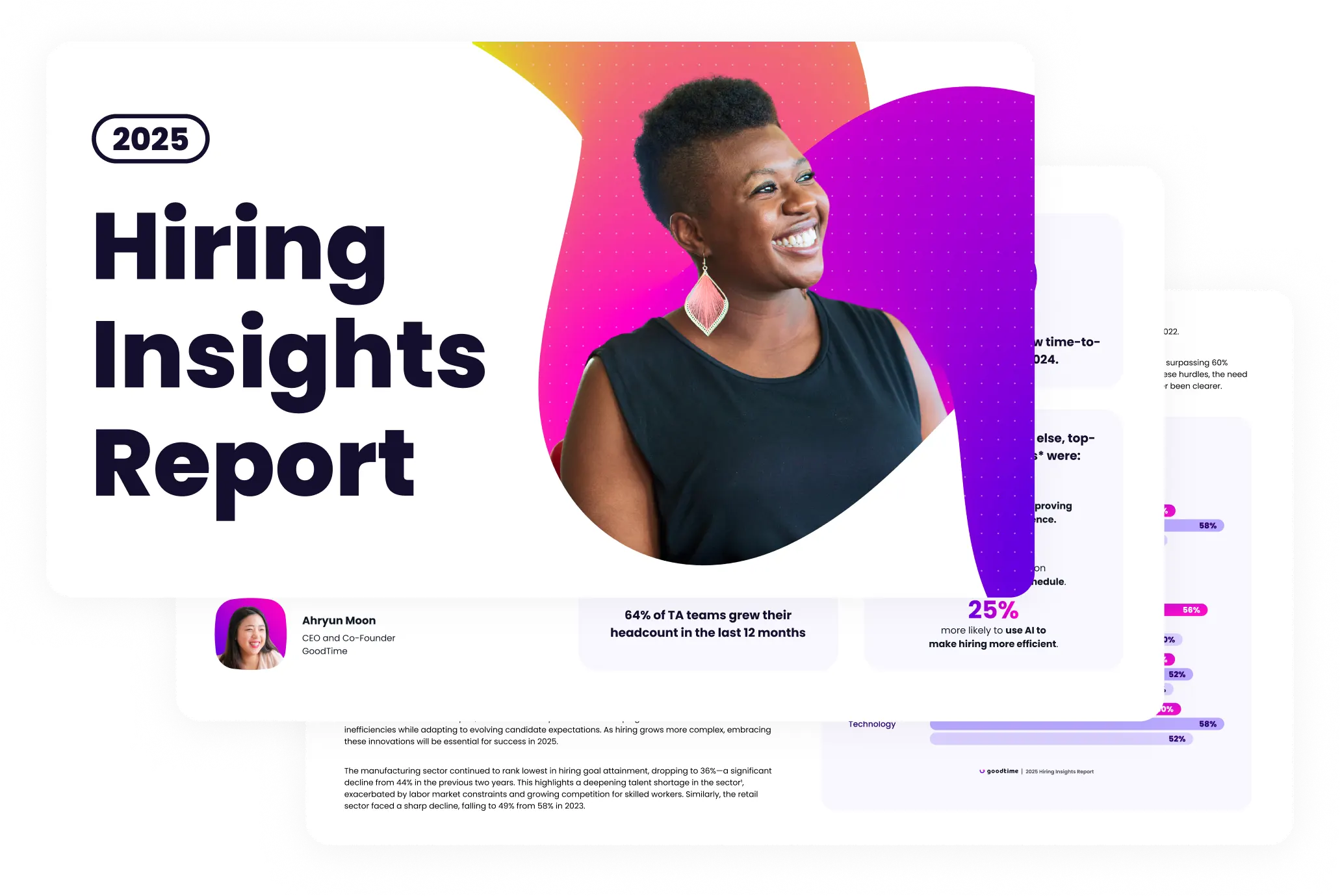Table of Contents
Did you know that 99% of talent acquisition teams use automation tools? If you’re not using them already, your competitors might leverage the benefits of automating the recruitment process to stay ahead. Meanwhile, you’re left struggling with the inefficiencies of manual hiring, such as slow interview scheduling and time-consuming resume screening.
Recruitment automation minimizes the time and effort wasted in inefficient manual operations. That way, you can secure top talent faster, more efficiently, and at a lower cost.
While automation reduces human intervention in the recruitment process, it can help you build strong connections with candidates. Below is a detailed breakdown of the benefits of automating your recruitment process and how it enables a human-centric approach when hiring talent.

Unlock 2025’s top hiring strategies: Insights from 500+ TA leaders
Be the first to uncover deep hiring insights specific to your sector — straight from the highest-performing TA teams.

1. Reduces time-to-hire
Manual, repetitive processes can seriously drag out recruitment, so you spend more time than necessary to fill a position.
Take manual interview scheduling, for example. You may suggest interview time slots only to find out that the job candidate isn’t free for any of them. On the other hand, the candidate may propose a schedule that clashes with your hiring timeline or doesn’t work for your team. As a result, scheduling takes way longer than expected. That means more delays and a longer time-to-hire.
Automation simplifies scheduling so that you can interview and recruit candidates faster. Tools like GoodTime integrate with digital calendars, such as Outlook and Google Calendar, letting you set up time slots for interviews. Candidates can easily pick the time that works best for them from the available options—no more endless back-and-forth that slows everything down. This can reduce the time it takes to hire talent.
Without full automation, the time between scheduling an interview and the actual interview is almost 180 hours. If you use interview scheduling software to fully automate the process, the figure comes down to about 146 hours.
2. Improves candidate experience
A negative candidate experience can make job seekers withdraw their applications, reject offers, or discourage others from applying. This shrinks your candidate pool, limiting your ability to hire the best talent quickly. It also ruins your reputation as an employer in the job market.
Automation improves candidate experience by speeding up processes and cutting down the time to hire. A quick hiring process shows you’re efficient and mindful of candidates’ time. But automation enhances candidate experience in other ways, too.
With automated personalized communication, you can deliver timely feedback and keep candidates informed about the status of their job applications. Text recruiting software provides a centralized platform for contacting candidates individually or in bulk through WhatsApp, email, and SMS. It can automatically send a personalized message when a candidate moves to the next stage of the interview process or if they get rejected. This way, you won’t leave applicants in the dark wondering whether they’ve landed the job, which can boost employer branding.
3. Increases recruiter productivity
When automation handles manual, repetitive tasks, your team can prioritize other important recruitment activities that require human effort, such as connecting with candidates. For example, GoodTime’s latest report revealed that recruitment teams spend 35% of their time scheduling interviews. Automating this task saves them more than 24 hours weekly to focus on higher-value work. This increases recruiter productivity.
The saved time is especially valuable now, as talent acquisition professionals face increased workloads due to massive layoffs that have significantly reduced the size of recruitment departments.
Mike Joyner, the founding partner at Growth by Design Talent and former recruitment leader at Pinterest, Facebook, and Apple, agrees:
“In the last year, we’ve seen companies reducing their recruiting coordination teams and, in some cases, eliminating the team entirely. This has put more of the administrative burden on full-cycle recruiters, who now really need automation in order to do their jobs. They are going to accomplish less if they take on tasks that unnecessarily burn time, like scheduling or initial reach-outs.”
He emphasizes that if your team does these high-volume tasks manually, recruiters won’t be able to hire as many people as they could with automation.
4. Enables data-driven recruitment optimization
Recruitment analytics tools provide intelligent insights you can use to improve your hiring efficiency. You can use them to track and analyze key metrics like:
- Time-to-hire
- Interview turnaround time
- Candidate experience scores
- Cancellation and rescheduling reasons
- Interviewer performance
With this information at your fingertips, it’s easy to identify areas to improve in your hiring process. You optimize recruitment based on hard facts instead of relying on guesswork or gut feelings.
Some recruitment intelligence tools provide more than basic recruitment analytics—they automatically find bottlenecks in your hiring process. They achieve this by analyzing your workflows, spotting patterns, and then flagging areas with inefficiencies. Instead of wasting time trying to figure out what’s wrong with your recruitment strategy, analytics solutions tell you exactly where the problem is and what action you can take to refine your hiring process.
Dallas Frazer, former Recruitment Operations Lead at Shopify, says: “Platforms like GoodTime massively increase our visibility into key recruiting metrics like time-to-hire. They allow recruiting teams to not only see overall time-to-hire but also pinpoint specific areas that might be causing delays, whether those delays are caused by the candidates, the recruiters, or the interviewers.”
5. Promotes consistency and fairness in hiring
One of the biggest benefits of automating your recruitment process is consistency. Automation ensures every candidate goes through the same procedure, no matter who’s handling the hiring. For example, with automated systems, you can ask the same assessment questions when screening candidates for a particular role.
When people applying for a certain position follow the same steps in the hiring process, you hold them to similar standards and expectations. This enhances fairness, which reflects positively on your company’s recruitment practices.
Professional recruiters aim to be objective when evaluating candidates. However, unconscious biases may sometimes creep into the recruitment process. Common human prejudices, such as racial, political, religious, and gender stereotypes, may prevent a perfectly qualified candidate from getting a job.
Automation can reduce human biases in the recruitment process. An applicant tracking system (ATS), for example, automates resume screening. After scanning resumes, it evaluates and ranks candidates based on objective criteria like skills, education, and other actual job requirements. This keeps the recruitment process fair and free from personal bias.
How automation enables a human-centric approach
People often think that automation removes the human touch out of a process. But when it comes to recruitment, it actually makes the process more human.
Sorting applications and reviewing resumes. Scheduling interviews. Following up with candidates. These repetitive tasks eat up recruiters’ time and distract them from their core responsibility—interacting with candidates and figuring out the best fit.
When you automate manual, repetitive tasks, your team won’t have to do them. This means recruiters have more time to have meaningful conversations with candidates. Instead of worrying about recurring administrative processes, they can focus on understanding a person’s motivations, culture fit, and long-term goals.
“Free up time for people to learn new skills and focus more on areas where human creativity is needed, such as candidate experience or optimizing processes. The right tool can be a great investment because it can help you automate repetitive tasks. It can free up time so that people can focus on something that requires deeper attention.”
-Valeria Stanga, Senior Talent Acquisition Partner | HelloFresh
Besides freeing up time for evaluating an applicant’s suitability, automation helps improve the candidate experience. For example, automated scheduling, interview reminders, and application status updates streamline the recruitment journey for job seekers.
An automation tool like GoodTime doesn’t replace but enhances recruiters’ capabilities and augments their potential. In other words, it empowers, rather than overrides, the human touch that is so crucial in recruitment. HR technology allows you to customize automation workflows so you can maintain the human touch that is unique to your hiring process.
The simple way to automate your recruitment process
Today, the competition for top talent is fiercer than ever before. If your hiring process is too long or slow, you risk losing top talent to competitors. With automation, you speed things up to enhance the candidate experience. You connect with qualified candidates and find the best fit for your business faster, shortening the recruitment process.
However, be careful when choosing an automation technology. Not all tools are easy to implement or meet your recruitment needs. You need a robust, user-friendly solution like GoodTime that makes your hiring process efficient. With it, you can:
- Automate interview scheduling: Schedule candidate interviews individually or in bulk without the hassle of dealing with time zone differences. Candidates and recruiters can easily find a perfect day and time that works for everyone without back-and-forth emails or SMS. Automated scheduling makes it easy to plan mass hiring events like Superdays.
- Customize workflow automation: Tailor automation rules to fit the specific needs of your talent acquisition team or the requirements of a particular role. You can set workflows to trigger interview invitations and reminders. Use advanced rules to automate essential elements of your hiring journey.
- Elevate candidate experience: Provide candidates with a centralized platform so they can easily access key interview info, interviewer profiles, communication options, and more. Collect anonymous feedback after every step of the interview process to show candidates you value their opinions. You can use the feedback to improve your recruitment strategy.
Learn more about GoodTime’s recruiting automation to see how it accelerates your hiring process and frees your team to focus on human-centric tasks.




